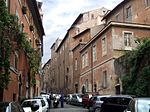Baths of Trajan

The Baths of Trajan (Italian: Terme di Traiano) were a massive thermae, a bathing and leisure complex, built in ancient Rome starting from 104 AD and dedicated during the kalendae of July in 109. Commissioned by Emperor Trajan, the complex of baths occupied space on the southern side of the Oppian Hill on the outskirts of what was then the main developed area of the city, although still inside the boundary of the Servian Wall. The architect of the complex is said to be Apollodorus of Damascus. The baths were being utilized mainly as a recreational and social center by Roman citizens, both men and women, as late as the early 5th century. The complex seems to have been deserted soon afterwards as a cemetery dated to the 5th century (which remained in use until the 7th century) has been found in front of the northeastern exedra. The baths were thus no longer in use at the time of the siege of Rome by the Ostrogoths in 537; with the destruction of the Roman aqueducts, all thermae were abandoned, as was the whole of the now-waterless Mons Oppius. Early Christian writers misnamed the remains the "Baths of Domitian".
Excerpt from the Wikipedia article Baths of Trajan (License: CC BY-SA 3.0, Authors, Images).Baths of Trajan
Viale Carlo Saviotti, Rome Municipio Roma I
Geographical coordinates (GPS) Address External links Nearby Places Show on map
Geographical coordinates (GPS)
| Latitude | Longitude |
|---|---|
| N 41.891866666667 ° | E 12.496280555556 ° |
Address
Thermae Traianae
Viale Carlo Saviotti
00184 Rome, Municipio Roma I
Lazio, Italy
Open on Google Maps











